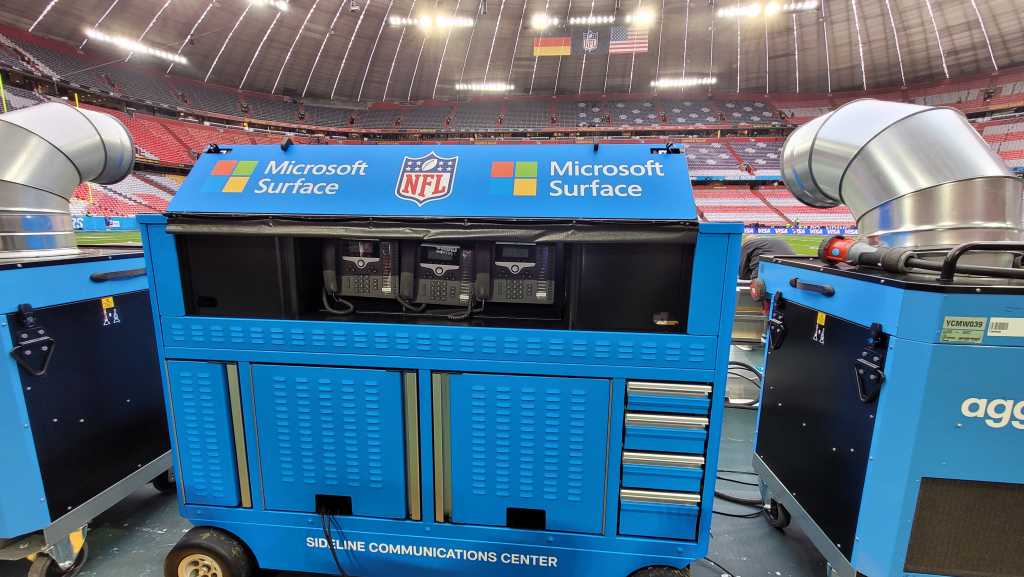
Touchdown! More than 70,000 fans celebrate the Carolina Panthers’ first points in Munich’s Allianz Arena on Nov. 10, and they can rewatch the action via instant replay on large video screens. The USA’s National Football League is visiting Munich.
While the fans cheer, the faces of Anish Patel, director of stadium & wireless engineering at the NFL, and Aaron Amendolia, deputy CIO of the NFL, slowly relax. TV broadcast, instant replay, access controls, Wi-Fi – all systems are green, and the network is up and running stably.
Building a network in one week
Patel and Amendolia had a tough week to get to that point. After all, Patel is responsible for the design and operation of the network infrastructure in NFL stadiums, regardless of whether it is for international games, US games or the Super Bowl. Amendolia, on the other hand, is more concerned with strategic aspects such as frequency management, since the NFL has to use different radio frequencies in Europe than it does in the USA.
Another big issue for the deputy CIO is privacy. Many services such as visitor tracking and processing of fan data, which are taken for granted in the US, cannot be used by the NFL in Europe due to GDPR.
Three containers of IT equipment
For the three-hour NFL spectacle in Munich, Patel, Amendolia and their teams had to build a complete network within a week, including a small data center, cyber defense capabilities, WLAN, private LTE, VoIP call manager, and fiber optic infrastructure – to name just a few components of the IT installation.
Patel illustrates how much work this is: “For the game in Munich alone, we brought three containers of equipment with us.” This includes switches, routers, access points, mmWave equipment, card scanners, tablets and lots of fiber optics. For on-premises hardware, the NFL relies on Cisco’s portfolio. “Cisco is our official cybersecurity and network infrastructure partner, including for the international games in London and Munich and in 2025 in Madrid and Berlin,” explains Amendolia.
srcset=”https://b2b-contenthub.com/wp-content/uploads/2024/11/20241110_114714.jpg?quality=50&strip=all 4032w, https://b2b-contenthub.com/wp-content/uploads/2024/11/20241110_114714.jpg?resize=300%2C168&quality=50&strip=all 300w, https://b2b-contenthub.com/wp-content/uploads/2024/11/20241110_114714.jpg?resize=768%2C432&quality=50&strip=all 768w, https://b2b-contenthub.com/wp-content/uploads/2024/11/20241110_114714.jpg?resize=1024%2C576&quality=50&strip=all 1024w, https://b2b-contenthub.com/wp-content/uploads/2024/11/20241110_114714.jpg?resize=1536%2C864&quality=50&strip=all 1536w, https://b2b-contenthub.com/wp-content/uploads/2024/11/20241110_114714.jpg?resize=2048%2C1152&quality=50&strip=all 2048w, https://b2b-contenthub.com/wp-content/uploads/2024/11/20241110_114714.jpg?resize=1240%2C697&quality=50&strip=all 1240w, https://b2b-contenthub.com/wp-content/uploads/2024/11/20241110_114714.jpg?resize=150%2C84&quality=50&strip=all 150w, https://b2b-contenthub.com/wp-content/uploads/2024/11/20241110_114714.jpg?resize=854%2C480&quality=50&strip=all 854w, https://b2b-contenthub.com/wp-content/uploads/2024/11/20241110_114714.jpg?resize=640%2C360&quality=50&strip=all 640w, https://b2b-contenthub.com/wp-content/uploads/2024/11/20241110_114714.jpg?resize=444%2C250&quality=50&strip=all 444w” width=”1024″ height=”576″ sizes=”(max-width: 1024px) 100vw, 1024px”>
The NFL requires different camera positions than the Bundesliga. Therefore, only part of the existing infrastructure can be used.
Hill
Terabits of data and NY command center
When asked how many gigabits/s the fiber optic network now has, Patel can only laugh. “We’re talking about terabits of speed here,” the network specialist explains. A look at the front of the stadium shows why Patel needs these speeds. This is where the giant trucks of the TV networks that are broadcasting the game to the USA are parked. And no one is talking about full HD anymore – UHD, i.e. 4k, is now part of good sound and picture.
But why all the effort? After all, Munich’s Allianz Arena is one of the most modern football stadiums in Europe. And its IT infrastructure with modern Wi-Fi, license plate screening in the parking garages, electronic access systems, networked cash register systems, etc. is nothing to be ashamed of.
Patel admits that infrastructure sharing is indeed practiced in stadiums such as the Allianz Arena. And in the Allianz Arena’s data center, in addition to the stadium’s permanently installed 19-inch racks, there are also a few half-size, rollable racks.
However, the IT infrastructure requirements for soccer and American football are too different. “It starts with the camera positions, which are in completely different places in football, so the pre-installed infrastructure is of no use to us,” explains Amendolia.
“We also need a fast connection to the Art McNally GameDay Central Command Center in New York, because that’s where the NFL officials, who are comparable to the German video referees, are based,” Patel points out, explaining another special feature. And on the sidelines, there are small blue trolleys containing tablets for the referees on site. They can use these to analyze unclear game situations in more detail using VR/AR and consult with their colleagues in New York in real time.
Also on the sidelines are IP phones that are controlled by Cisco Call Manager. These allow the team coaches to contact the tacticians and other experts in the backend.
On the sidelines there are mobile communications centers with VoIP phones and tablets.
Hill
Core network and edge computing
And there is another reason for the NFL to have its own infrastructure: security. “We need our own core network that will still work even if we are cut off from the outside world in terms of IT, in order to ensure smooth game operations,” emphasizes network designer Patel.
To do this, the network specialist is pursuing an edge computing approach. At its core, the network for the actual game operates with a small mobile data center. All other services such as TV broadcasts etc. then run at the edge.
“We have already separated the network from the rest of the infrastructure at the physical layer,” he adds. In addition, the network should function without disruptions and unexpected peaks in load. After all, the NFL has measured loads of up to 20 Gbit/s in the guest Wi-Fi networks in the stadium.
Furthermore, strict endpoint controls are in place in the core network. And devices can only log in using two-factor authentication.

NFL mobile data and network center in the Allianz Arena data center.
Hill
Deputy CIO Amendolia uses the example of the Super Bowl in February to illustrate how important this strict security policy is: “At that time, we successfully blocked 39,000 security-relevant events and 354,000 connections to or from blacklisted areas of the world.”
Amendolia relies on NFL partner Cisco and its cloud-based security portfolio, including Cisco Umbrella, Cisco XDR, Cisco Firepower and Cisco Secure Malware Analytics.
This story originally appeared on Computerworld Germany.
Source:: Network World
